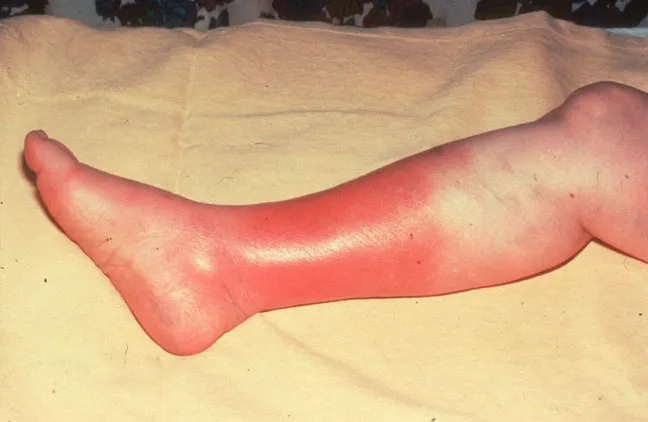When should I see a doctor about a skin rash?
Skin rashes are common and can be itchy, unsightly and irritating. But when should you see a doctor?
In this article we will describe 10 reasons to see a doctor about a skin rash.
 Cellulitis
Cellulitis
This condition is a medical emergency. Urgent care is required, including intravenous antibiotics.
- It’s all over the body – and/or starts and spreads quickly. This could be a sign of an allergic reaction.
- It hurts – especially if it is painful, red and infected. It could be oozy, crusty, warm to the touch, or have red streaks. Cellulitis (above) is an example.
- It gives you a fever – temperature of 38C or higher.
- It starts to blister – especially near your eyes, mouth, or genitals.
- It affects warm folds of the skin – like between your fingers, under your breasts or in your groins. It could be a fungal infection.
- It is linked to shortness of breath. Why? Urticaria (hives/welts). These are reddish swollen-looking bumps or blotches on your skin. They tend to be very itchy and may burn or sting. They occur when your body reacts to certain foods or allergens.

The blotches usually go away within a day. You can usually treat it at home. See a doctor if:- Your throat swells and you are having difficulty breathing
- You are short of breath
- Your itching is very bad
- Your symptoms last longer than a couple of days.
- You are itching (pruritus) a lot – especially if it all over the body. See a doctor if:
- Home treatment doesn’t help or the itch lasts more than a couple of weeks
- The itch comes on suddenly and is all over your body. You could have an allergic reaction or thyroid, kidney or liver disease
- The itch keeps you awake or makes it hard to go about your day.
- Burns and sunburn. See a doctor if:
- Your burn yourself with chemicals or from touching electricity
- You have signs of infection, like swelling, pus, or red streaks from blisters
- The burn covers a large part of your body.
- Acne. See a doctor if:
- If your acne is severe, with many breakouts that go deep into your skin, or you see scarring
- You see lots of blackheads, whiteheads, or both.
- Meningitis. There are many types of meningitis. All are serious. Meningococcal (bacterial) is especially dangerous. See a doctor TODAY if you suspect any type of meningitis, especially that one.
 Meningitis glass test
Meningitis glass test
A rash that does not fade under pressure can be a sign of meningococcal septicaemia (meningococcal bacteria can cause meningitis and septicaemia).
Note. In meningitis there is not always a headache and neck stiffness. There may only be a rash and a fever.
Summary
We have described when you should see a doctor about a skin rash. We hope it has been helpful.

